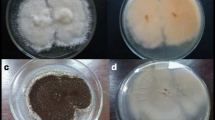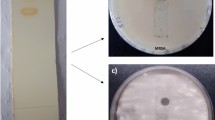Abstract
In all 312 actinomycete strains were isolated from water and soil samples from different regions. All these isolates were purified and screened for their antifungal activity against pathogenic fungi. Out of these, 22% of the isolates exhibited activity against fungi. One promising strain,Streptomyces albidoflavus PU 23 with strong antifungal activity against pathogenic fungi was selected for further studies. Antibiotic was extracted and purified from the isolate.Aspergillus spp. was most sensitive to the antibiotic followed by other molds and yeasts. The antibiotic was stable at different temperatures and pH tested and there was no significant loss of the antifungal activity after treatment with various detergents and enzymes. Synergistic effect was observed when the antibiotic was used in combination with hamycin. The antibiotic was fairly stable for a period of 12 months at 4°C. The mode of action of the antibiotic seems to be by binding to the ergosterol present in the fungal cell membrane resulting in the leakage of intracellular material and eventually death of the cell. The structure of the antibiotic was determined by elemental analysis and by ultraviolet (UV), Fourier transform infrared (FTIR), nuclear magnetic resonance (NMR) and liquid chromatography mass spectra (LCMS). The antibiotic was found to be a straight chain polyhydroxy, polyether, non-proteinic compound with a single double bond, indicating a nonpolyene antifungal antibiotic
Similar content being viewed by others
Abbreviations
- BJMC:
-
Byramjee Jeejeebhoy Medical College
- DEPT:
-
distortionless enhancement by polarization transfer
- DSS:
-
dimethyl silapentane sulfonate
- FTIR:
-
Fourier transform infrared
- LCMS:
-
liquid chromatography mass spectrum
- MFC:
-
minimum fungicidal concentration
- MIC:
-
minimum inhibitory concentration
- MTCC:
-
microbial type culture collection
- NCCLS:
-
National Committee for Clinical Laboratory Standards
- NCIM:
-
National Collection of Industrial Microorganisms
- NMR:
-
nuclear magnetic resonance
- NRRL:
-
Northern Regional Research Laboratory
- SDA:
-
Sabouraud dextrose agar
- SDS:
-
sodium dodecyl sulphate
- TLC:
-
thin-layer chromatography
- UV:
-
ultraviolet
References
Anderson A S and Wellington E M H 2001 The taxonomy ofStreptomyces and related genera;Int. J. Syst. Evol. Microbiol. 51 797–814
Augustine S K 2004Bioactive compounds from actinomycetes with a potential to inhibit pathogenic fungi, Ph. D. Thesis, University of Pune, Pune
Augustine S K, Bhavsar S P, Baserisalehi M and Kapadnis B P 2004 Isolation, characterization and optimization of antifungal activity of an actinomycete of soil origin;Indian J. Exp. Biol. 42 928–932
Barry A L 1980 Procedure for testing antibiotics in agar media: Theoretical considerations; inAntibiotics in laboratory medicine (ed.) V Lorian (Baltimore: Williams and Wilkins) pp 1–23
Beck-Sague C Mand Jarvis W R 1993 Secular trends in the Epidemiology of nosocomial fungal infections in the United States 1980–1990;J. Infect. Dis. 167 1247–1251
Bevan P, Ryder H and Shaw I 1995 Identifying small-molecule lead compounds: The screening approach to drug discovery;Trends Biotechnol. 113 115–121
Cappuccino J G and Sherman N 1999Microbiology — A laboratory manual (Harlow: Benjamin) pp 263–264
Collins C H, Lyne P M and Grange J M 1995Microbiological methods (London: Butterworth and Heinnemann) pp 155–168
Cragg G M, Newman D J and Snader K M 1997 Natural product: in drug discovery and development;J. Nat. Prod. 60 52–60
Dasgupta F 1998 Antifungal agents — past, present and future possibilities; inAntifungal agents past, present, future prospect (eds) R S Varma, I K Khan and A P Singh (Lucknow: Academy of Chemistry and Biology) pp 29–54
Franco M M C and Countinho L E L 1991 Detection of novel secondary metabolites;Crit. Rev. Biotechnol. 11 193–276
Georgopapadakou N H and Tkacz J S1994 Human mycoses: Drugs and targets for emerging pathogens;Science 264 371–373
Georgopapadakou N H and Tkacz J S 1996 Antifungal agents: chemotherapeutic targets and immunogenic strategies;Anti-microb. Agents Chemother. 40 279–291
Glazer A N and Nikaido H1995 Antibiotics; inMicrobial biotechnology (New York: W H Freeman) pp 431–451
Gupte M, Kulkarni Pand Ganguli B N 2002 Antifungal Antibiotics;Appl. Microbiol. Biotechnol. 58 46–57
Hammer K A, Carson C F and Riley T V 2002In vitro activity ofMelaleuca alternifolia (tea tree) oil against dermatophytes and other filamentous fungi;J. Antimicrob. Chemother. 50 195–199
Igraham J L and Igraham C A 2000 Pharmacology; inIntroduction to microbiology Second edition (Singapore: Thomson Asia) pp 532–561
Lavermicocca P, Valerio F and Visconti A2003 Antifungal activity of phenyl lactic acid against molds isolated from bakery products;Appl. Environ. Microbiol. 69 634–640
Lebbadi M, Galvez A, Maqueda M, Martinez-Bueno M and Valdivia E1994 Fungicin M-4: a narrow spectrum peptide antibiotic fromBacillus licheniformis M-4;J. Appl. Bacteriol. 78 49–53
Motta A S and Brandelli A 2002 Characterization of an antibacterial peptide produced byBrevibacterium linens;J. Appl. Microbiol. 92 63–70
Munimbazi C and Bullerman L B 1998 Isolation and partial characterization of antifungal metabolites ofBacillus pumilus;J. Appl. Microbiol. 84 959–968
Petrou M A and Shanson D C 2000 Susceptibility ofCryptococcus neoformans by the NCCLS microdilution and E test methods using five defined media;J. Antimicrob. Chemother. 46 815–818
Phae C G, Shoda M and Kubota H 1990 Suppressive effect ofBacillus subtilis and its products on phytopathogenic microorganisms;J. Ferment. Bioeng. 69 1–7
Prescott M L, Harley J P and Klein D A 2002 Antimicrobial chemotherapy; inMicrobiology Fifth edition (New York: McGraw Hill) pp 806–825
Shadomy S1987 Preclinical evaluation of antifungal agents; inRecent trends in the discovery, development and evaluation of antifungal agents (New Jersey: Prous Science) pp 8–14
Shadomy S, Espinel-Ingroff A and Cartwright R Y 1985 Laboratory studies with antifungal agents: Susceptibility tests and bioassays; inManual of clinical microbiology (eds) E H Lenette, A S Balows and W J Hausle (Washington: American Society for Microbiology) pp 991–999
Singh R and Garg S R 2003 Detection and characterization of enterocins fromEnterococcus sp;Indian J. Exp. Biol. 41 609–613
Author information
Authors and Affiliations
Corresponding author
Rights and permissions
About this article
Cite this article
Augustine, S.K., Bhavsar, S.P. & Kapadnis, B.P. A non-polyene antifungal antibiotic fromStreptomyces albidoflavus PU 23. J. Biosci. 30, 201–211 (2005). https://doi.org/10.1007/BF02703700
Received:
Accepted:
Published:
Issue Date:
DOI: https://doi.org/10.1007/BF02703700




